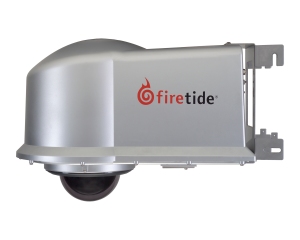During our recent webinar to the channel, I got a number of questions, answers to which I am posting here, with the hope that they will address some of the common questions our readers may have on Firetide’s technology.
Mesh Operation and Product Interoperability
Question: Can both radios in the same mesh node transmit at the same time? If so, what is the max throughput each radio can transmit simultaneously?
Yes, both radios can transmit at the same time. You can set each radio to transmit on different frequencies (2.4, 4.9, or 5GHz) and on different channels.
The maximum throughput on each radio will depend on the RF environment, the length of the link, and the spectrum used. In outdoor settings using MIMO mesh nodes, our customers have achieved up to 180 Mbps of UDP throughput on a 4.9 GHz link, and up to 150 Mbps of UDP throughput on a 5 GHz link.
These numbers can be reached when using relatively clear 40 MHz channels. Since there’s only one 40 MHz channel available in the 4.9 GHz spectrum, you cannot ‘double’ the 180 Mbps throughput, and have to use the second radio in a different spectrum for maximum overall throughout.
Question: Do you support Spanning tree protocol?
Firetide mesh nodes pass Spanning tree BPDUs (Bridge Protocol Data Units). This feature is available via the HotView Pro network management system; the mesh nodes do not support Spanning tree ‘out of the box.’ On a related note, Firetide implemented its own loop detection mechanism for broadcast containment.
Question: What is the bandwidth for the 900 MHz radios?
Bandwidth on 900 MHz links will be very site specific due to the nature of near-line-of-sight or non-line-of-sight environments. You may also need use specialized antennas, such as yagis, for best performance. Throughput we’ve seen in customer installations ranges from 1 to 5 Mbps when operating on a 5 MHz channel (which is typically used for near- or non-line-of-sight deployments, as opposed to 20 or 40 MHz channels used for line-of-sight deployments).
Question: Can the current 7000 series communicate with the 6000-900 radios in the same mesh?
Yes, the HotPort 7000 series can communicate with the HotPort 6000-900 (900 MHz) nodes in the same mesh. The non-MIMO 7000 mesh nodes will perform exactly as HotPort 6000 series when connecting to the HotPort 6000-900 over the radio operating on 2.4, 4.9 or 5 GHz. (HotPort 6000-900 are dual-radio nodes, with one radio operating in 900 MHz and other operating in 2.4, 4.9 or 5 GHz.)
If the 7000 mesh node is MIMO-enabled and is operating using 802.11n radio technology, it can still communicate with a HotPort 6000-900 mesh node, over the 2.4/4.9/5 GH radio link. In this case, the MIMO mesh node reverts to non-MIMO operation, on a per link basis, to establish a connection with the HotPort 6000-900.
Firetide IVS-100 Integrated Video Enclosure
Question: What kind (SSD vs hard drive) of onboard storage is in the IVS units and how much storage is available?
If you order the Firetide IVS-100 (integrated video enclosure) with an analog camera, the system will be equipped with an analog-to-IP encoder, which also acts as on-board storage. The encoder includes an 80 GB hard drive, providing several days of onboard storage when recording at 30 frames per second in standard resolution. Currentlty, onboard storage is only available if you order the system with an analog camera.
Question: What are the specs for the analog camera specified in the Firetide enclosure: TVL, auto iris, auto focus, etc?
The analog camera used in the enclosure is a high-end outdoor camera. Feature highlights include: day/night operation; high-resolution integrated camera/optics package; 540 TVL; 128X wide dynamic range (WDR); motion detection; electronic image stabilization; autofocus; automatic iris control with manual override; 35X optical, 12X digital zoom. If you need more information on the camera, please contact Firetide or Anixter (exclusive distributor for the IVS system).
Question: Will the IVS be made available in a “bring your own camera” configuration?
IVS units are built to order, so customers can specify their preferred cameras, as long as they fit into the enclosure with minimal modifications to the enclosure hardware. The cameras must be outdoor rated with extended operating range. Minimum order quantities may apply for a custom project.
FIPS 140-2 Validated Mesh
Question: From what I understand, there are 4 levels of security for the FIPS 140-2. What level of FIPS 140-2 certification did you receive?
Firetide HotPort 7000 mesh nodes have been certified at “overall level 2,” while EMI/EMC components have been certified to Level 3. See NIST database: http://csrc.nist.gov/groups/STM/cmvp/documents/140-1/1401val2010.htm
Note that only the MIMO version of our mesh has been FIPS 140-2 certified, so non-MIMO mesh is not available with FIPS 140-2 validation.
Question: Are there other mesh providers whose equipment is FIPS 140-2 certified?
Yes, I’m aware of one other wireless mesh provider whose wireless mesh equipment is FIPS 140-2 certified. However, their throughput for the MIMO product is around 12 to 18 Mbps, according to press reports from 2009. The company’s press release cites a customer as follows: “To test the performance, we replaced a cluster of [non-MIMO] with [MIMO nodes], and saw a node-to-node throughput increase from 6 Mbps to 15 Mbps.” This is a far from Firetide’s MIMO performance, and is even below the performance of our non-MIMO mesh.
Do you have any other questions on Firetide wireless infrastructure mesh, WLAN or point-t0-point technology? If yes, please leave a comment below or email me directly at kcoffman-at-firetide-dot-com.
See also:
- Firetide Unifies Wireless Infrastructure Mesh Product Line; Adds Flexible Capacity Options
- Mesh Provider Jumps into 802.11n Wireless LAN Fray
- MIMO Wireless Bridge Joins Firetide’s Point-to-point Portfolio

what is the best range of RSSi use it is -70db only, or it is above that or below that value.
Comment by syafiq — June 16, 2011 @ 7:29 pm |